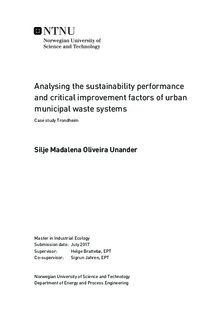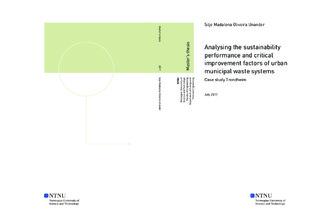| dc.description.abstract | The management of the natural output of consumption, waste, has to become more sustainable. Ideally this would mean that it simply ceased to exist, but as unrealistic that may be, the current discourse in waste legislation and management is on increasing the material recycling rate. This is a part of the circular economy. Analysing waste management systems is crucial to know what effect different measures might have on the actual recycling rate. In turn, these measures might impact the energy consumption related to all this waste management.
To comply with future possible new policy targets related to the circular economy and decrease its environmental impacts, the municipality in Trondheim intends to implement several measures to improve its waste management. A dual-layer material flow analysis model was developed and customized, and scenarios designed to test the effects of planned measures in Trondheim's waste management.
The scenarios with an improved central sorting facility and improved household sorting efficiency gained the highest material recycling rates, while having a negative impact on the system energy efficiency as a result of more energy consumption in treatment and less energy output from the local incineration plant. The energy efficiency was highest in the scenario where most waste was sent for incineration with co-generating heat. The fraction with the highest impact on material efficiency compared to the reference scenario was the organic waste fraction, due to it not being collected in the reference scenario in the first place, and due to the large share it constitutes of the total waste generated.
With the material recycling rate as defined in the model, the municipal material recycling target of 50% were met for both exploratory improvement scenarios, whereas only the perfect household scenario reached the target in 2020. All scenarios failed to reach the target of 70% material recycling of household solid waste in 2030. Yet there is hope, as the real material recycling rate is likely to be higher due to waste categories and sources not included in this mode. To reach probable future targets as legislated by the EU, this study recommends that the municipality go forth with its current plans, but additional effort in improving household sorting is required to have a realistic chance at the increased future targets set by the EU. | |

